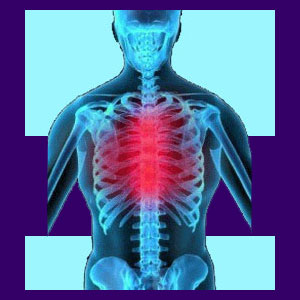
Middle back injury is the least often seen type of spinal trauma, but can occur under particular circumstances and lead to serious pain. The middle back is well protected by the organic design of the vertebral components, as well as the attachment to the ribcage for added durability. The mid back is not called upon to bend or flex in the same manner as the neck and lower back, making it naturally resistant to most types of injury.
However, when trauma does occur to the middle back region, the spinal and soft tissues can be affected. Chronic middle back pain is a rare presentation for patients to demonstrate, but may result from the worst forms of injury to the spine. Typically, soft tissue injuries will heal much faster and with less lingering consequences.
This essay explores how and why the middle back might suffer injury. We will also examine the consequences of back injury and why these conditions can pose serious problems when it comes to successful treatment.
Causes of Middle Back Injury
As noted above, the usual reasons for back injury do not often apply too the middle back, due to its limited range of motion and strong design. The discs do not suffer the same degree of degeneration as the discs in the neck and lower back. Similarly, the arthritic processes are not often seen in the middle back to any significant degree. These facts make the mid back resistant to such diagnoses as herniated discs, degenerative disc disease, spinal osteoarthritis, facet joint syndrome and many others.
Since the entire region is stable and not overly flexible, muscular forms of back pain are equally rare. Imbalances and strain injuries are least often seen in the middle back region and when they do occur, they typically occur on the flanks, rather than near the center spine itself.
This leaves only uncommon events as the leading causes of middle back injury, including car accidents, falls from heights, acts of violence and sports injuries. Even in these circumstances, neck injury and lower back injury are exponentially more commonplace. Therefore, only select circumstances might lead to mid back trauma and subsequent lasting symptomology.
In less common cases, congenital or development defects in the middle spine might dispose the area to injury, but this is the least often seen type of traumatic presentation.
Symptoms of Middle Back Injury
Pain is the most common expression of middle back trauma and is usually experienced in the muscular tissues of the middle back. When a spinal structure is injured, pain might exist affecting the central nervous system and therefore may also influence neurological functionality in some cases.,
Pinched nerves may occur and can cause tingling, numbness and weakness in innervated parts of the anatomy. Central spinal cord injuries in the middle back can have dramatic presentations in the lower body including neurological deficits and various forms of partial and complete paralysis from the injured level downwards.
Being that the middle back is not flexible to a large degree, injuries tend to heal faster here than in the neck or lower back, where normal functionality tends to aggravate pain. When pain becomes a chronic concern in the middle back, exploration of the origin might prove difficult. In many cases, no structural reason is located, while in others, incidental structural atypicalities are unjustly blamed for creating lingering pain post-trauma.
Treatment for Mid Back Injury
Symptomatic treatment is most common for mid back injury. Usually, the patient will receive care to minimize pain while allowing the injury to resolve organically. In these cases, we strongly recommend avoiding pharmaceutical interventions in favor of natural and holistic care that is non-damaging to the body.
When pain is severe or trauma is significant, treatment might escalate quickly to include injections or surgical therapy. It should be noted that in most cases of severe and chronic back pain, surgery is not needed or often successful. Therefore, patients are strongly cautioned to get multiple diagnostic and treatment opinions before agreeing to surgical care.
For patients with a history of unsuccessful treatment or very severe pain that defies logic given the extent of most typical injuries, we strongly recommend investigating knowledge therapy as the best course of action. Curative statistics for this therapeutic path are excellent and definitely provide the possibility for favorable pain resolution, despite the failure of many treatments in the past.




